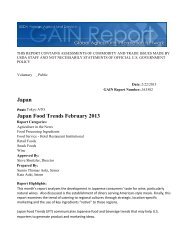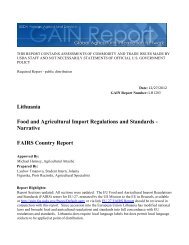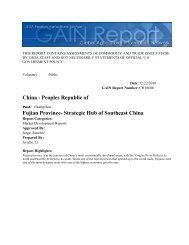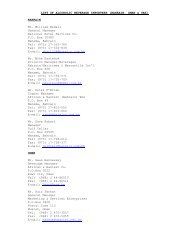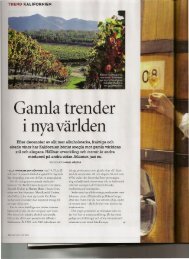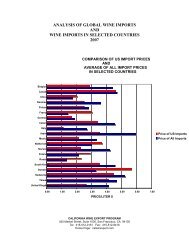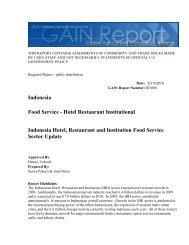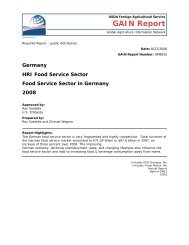Brazil Wine Market Report JBC EMP July 2011 - California Wine ...
Brazil Wine Market Report JBC EMP July 2011 - California Wine ...
Brazil Wine Market Report JBC EMP July 2011 - California Wine ...
Create successful ePaper yourself
Turn your PDF publications into a flip-book with our unique Google optimized e-Paper software.
38<br />
<strong>Brazil</strong>ian <strong>Wine</strong> <strong>Market</strong> <strong>Report</strong><br />
Section II<br />
Oenological practices allowed the grapes to Industrialization<br />
Article 10. Screening or selection of grapes is to:<br />
I - separate the berries unsuitable for winemaking, or<br />
II - classify grapes according to the degree of maturation.<br />
Article 11. Crush the film is to break the berries and crush them in order to release the<br />
must for:<br />
I - ensure the dissemination of the shell elements soluble in the wort, and<br />
II - to facilitate the multiplication of yeasts.<br />
Article 12. Stalk consists of separating the berries from the stalk in order to reduce the loss<br />
of color and alcohol in red wine and make it less rich and less undesirable astringent<br />
tannins.<br />
Article 13. Egouttage or exhaustion is to leave the crushed grape juice drain before<br />
pressing, for a wine with less substance coming from the grapes, skins and seeds.<br />
Article 14. Pressing is to press the grapes and the bark to extract the liquid part. The<br />
pressing can be performed in whole grapes or grape previously de-stemmed and crushed.<br />
Article 15. Maceration is to retain the solid part of the grapes in contact with the must in<br />
order to promote the dissolution of substances present in the film Berry.<br />
§ 1 is to keep traditional maceration for a period, the solid part in contact with the<br />
net, after stripping and crushing.<br />
§ 2 The carbonic maceration is to keep the whole grape in closed tank for a few days<br />
rich atmosphere containing carbon dioxide.<br />
§ 3 The hot mash is to heat the whole grapes or stalked or crushed by a period of<br />
time, before fermentation in order to quickly extract and materials more efficiently<br />
dyes and other substances in the film, being forbidden the heating steam injection<br />
Direct.<br />
§ 4 The Cold maceration is to cool the whole grapes or stalked or crushed before<br />
pressing or fermentation depending on the type of wine, in order to facilitate the<br />
extraction of constituents of the film and to increase the aromatic complexity and<br />
taste of wine.<br />
§ 5 The mash is to add sulfur sulfur dioxide or its salts to the mash with the<br />
sulphited must aim to produce for the development of the grape.<br />
§ 6 During the grape maceration enzyme may be added in order to facilitate the<br />
acquisition wort, débourbage operations, extraction of the pigments and polyphenols<br />
and extraction aromas and aromatic precursors Film Berry.<br />
Article 16. Enrichment involves increasing the sugar content of grapes harvested, until the<br />
desired level, through the following procedures:<br />
§ 1 Passificação:<br />
I - Natural: exposure of grapes on a surface or suspended during the time under the<br />
sun or in shaded naturally ventilated enclosure, and<br />
II - Forced: maintenance of the grapes in climate-controlled air circulation and dry or<br />
dehydrated, eventually warmed up.<br />
§ 2 selective screening is to select the grapes, from grapes and berries of grapes<br />
mature.<br />
§ 3 Cryo concentration is to partially freeze the grapes followed by a whole pressing<br />
the low temperature.



